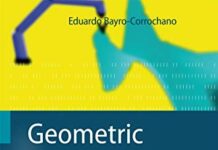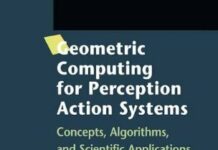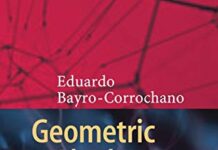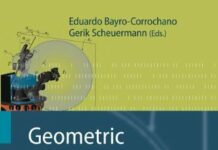
Ebook Info
- Published: 2001
- Number of pages: 618 pages
- Format: PDF
- File Size: 18.59 MB
- Authors: Eduardo Bayro Corrochano
Description
The goal of this book is to present a unified mathematical treatment of diverse problems in mathematics, physics, computer science, and engineer ing using geometric algebra. Geometric algebra was invented by William Kingdon Clifford in 1878 as a unification and generalization of the works of Grassmann and Hamilton, which came more than a quarter of a century before. Whereas the algebras of Clifford and Grassmann are well known in advanced mathematics and physics, they have never made an impact in elementary textbooks where the vector algebra of Gibbs-Heaviside still predominates. The approach to Clifford algebra adopted in most of the ar ticles here was pioneered in the 1960s by David Hestenes. Later, together with Garret Sobczyk, he developed it into a unified language for math ematics and physics. Sobczyk first learned about the power of geometric algebra in classes in electrodynamics and relativity taught by Hestenes at Arizona State University from 1966 to 1967. He still vividly remembers a feeling of disbelief that the fundamental geometric product of vectors could have been left out of his undergraduate mathematics education. Geometric algebra provides a rich, general mathematical framework for the develop ment of multilinear algebra, projective and affine geometry, calculus on a manifold, the representation of Lie groups and Lie algebras, the use of the horosphere and many other areas. This book is addressed to a broad audience of applied mathematicians, physicists, computer scientists, and engineers.
User’s Reviews
Reviews from Amazon users which were colected at the time this book was published on the website:
⭐Part I Advances in Geometric AlgebraChapter 1Old Wine in New Bottles: A New Algebraic Framework for Computational Geometry,David Hestenes1.1 Introduction1.2 Minkowski Algebra1.3 Conformal Split1.4 Models of Euclidean Space1.5 Lines and Planes1.6 Spheres and Hyperplanes1.7 Conformal and Euclidean Groups1.8 Screw Mechanics1.9 ConclusionsChapter 2Universal Geometric AlgebraGarret Sobczyk2.1 Introduction2.2 The Universal Geometric Algebra2.3 Matrices of Geometric Numbers2.4 Linear Transformations2.5 Pseudo-Euclidean Geometries2.6 Affine and Projective Geometries2.7 Conformal TransformationsChapter 3Realizations of the Conformal GroupJose Maria Pozo and Garret Sobczyk3.1 Introduction3.2 Projective Geometry3.3 The Conformal Representant and Stereographic Projection3.4 Conformal Transformations and Isometries3.5 Isometries in No3.6 Compactification3.7 Mobius TransformationsChapter 4Hyperbolic GeometryHongbo Li4.1 Introduction4.2 Hyperbolic Plane Geometry with Clifford Algebra4.3 Hyperbolic Conformal Geometry with Clifford Algebra4.4 A Universal Model for the Conformal Geometries of the Euclidean, Spherica and Double-Hyperbolic Spaces4.5 ConclusionPart II Theorem ProvingChapter 5Geometric Reasoning With Geometric AlgebraDongming Wang5.1 Introduction5.2 Clifford Algebra for Euclidean Geometry5.4 Proving Identities in Clifford AlgebraChapter 6Automated Theorem ProvingHongbo Li6.1 Introduction6.2 A general Framework for Clifford algebra and Wu’s Method6.3 Automated Theorem Proving in Euclidean Geometry and Other Classical Geometries6.4 Automated Theorem Proving in Differential Geometry}{116}6.5 ConclusionPart III Computer VisionChapter 7The Geometry Algebra of Computer VisionEduardo Bayro Corrochano and Joan Lasenby7.1 Introduction7.2 The Geometric Algebras of 3-D and 4-D Spaces7.3 The Algebra of Incidence7.4 Algebra in Projective Space7.5 Visual Geometry of $n$ Uncalibrated Camera7.6 ConclusionsChapter 8Using Geometric Algebra for Optical Motion CaptureJoan Lasenby and Adam Stevenson8.1 Introduction8.2 External and Internal Calibration8.3 Estimating the External Parameters8.4 Examples and Results8.5 Extending to Include Internal Calibration8.6 ConclusionsChapter 9Bayesian Inference and Geometric Algebra: An Application to Camera LocalizationChris Doran9.1 Introduction9.2 Geometric Algebra in Three Dimensions9.3 Rotors and Rotations9.4 Rotor Calculus9.5 Computer Vision9.6 Unknown range data9.7 Extension to three cameras9.8 ConclusionsChapter 10Projective Reconstruction of Shape and Motion Using Invariant TheoryEduardo Bayro Corrochano and Vladimir Banarer10.1 Introduction10.2 3-D Projective Invariants from Multiple Views10.3 Projective Depth10.4 Shape and Motion10.5 ConclusionsPart IV RoboticsChapter 11Robot Kinematics and Flags11.1 Introduction11.2 The Clifford Algebra11.3 Flags11.4 Robots11.5 Concluding RemarksChapter 12The Clifford Algebra and the Optimization of Robot DesignShawn G. Ahlers and John Michael McCarthy12.1 Introduction12.2 Literature Review12.3 Overview of the Design Algorithm12.4 Double Quaternions12.5 The Task Trajectory12.6 The Design of the TS Robot12.7 The Optimum TS Robot12.8 ConclusionChapter 13Eduardo Bayro Corrochano and Garret Sobczyk13.1 Introduction13.2 The General Linear Group13.3 Algebra of Incidence13.4 Rigid Motion in the Affine Plane13.5 Application to Robotics13.6 Application II: The design of an image filter Recognition of hand gestures The meet filter13.7 ConclusionPart V Quantum and Neural Computing, and WaveletsChapter 14Geometric Algebra in Quantum Information Processingby Nuclear Magnetic ResonanceTimothy F. Havel, David G. Cory, Shyamal S. Somaroo, and Ching-Hua Tseng14.1 Introduction14.2 Multiparticle Geometric Algebra14.3 Algorithms for Quantum Computers14.4 NMR and the Product Operator Formalism14.5 Quantum Computing by Liquid-State NMR14.6 States and Gates by NMR14.7 Quantum Simulation by NMR14.8 Remarks on Foundational IssuesChapter 15Geometric Feedforward Neural Networks and Support Multivector MachinesEduardo Bayro Corrochano and Refugio Vallejo15.1 Introduction15.2 Real Valued Neural Networks15.3 Complex MLP and Quaternionic MLP15.4 Geometric Algebra Neural Networks15.5 Learning Rule15.6 Experiments Using Geometric Feedforward Neural Networks15.7 Support Vector Machines in Geometric Algebra15.8 Experimental Analysis of Support Multivector Machines15.9 ConclusionsChapter 16Image Analysis Using Quaternion WaveletsLeonardo Traversoni16.1 Introduction16.2 The Static Approach16.3 Clifford Multiresolution Analyses16.4 Haar Quaternionic Wavelets16.5 A Dynamic Interpretation16.6 Global Interpolation16.7 Dealing with Trajectories16.8 ConclusionsPart VI Applications to Engineering and PhysicsChapte 17Objects in Contact: Boundary Collisions as Geometric Wave PropagationLeo Dorst17.1 Introduction17.2 Boundary Geometry17.3 The Boundary as a Geometric Object17.4 Wave Propagation of Boundaries17.5 ConclusionsChapter 18 Modern Geometric Calculations in CrystallographyG. Aragon, J.L. Aragon, F. Davila, A. Gomez and M.A. Rodriguez18.1 Introduction18.2 Quasicrystals18.3 The Morphology of Icosahedral Quasicrystals18.4 Coincidence Site Lattice Theory18.5 ConclusionsChapter 19 Quaternion Optimization Problems in EngineeringLjudmila Meister19.1 Introduction19.2 Properties of Quaternions19.3 Extremal Problems for Quaternions19.4 Determination of Rotations19.5 The Main Problem of Orientation19.6 Optimal Filtering and Prediction19.7 SummaryChapter 20Clifford Algebras in Electrical EngineeringWilliam Baylis20.1 Introduction20.2 Structure of Cl_320.3 Paravector Model of Spacetime20.4 Using Relativity at Low Speeds20.5 Relativity at High Speeds20.6 ConclusionsChapter 21Applications of Geometric Algebra in Physics and Links With EngineeringAnthony Lasenby and Joan Lasenby21.1 Introduction21.2 The Spacetime Algebra21.3 Quantum Mechanics21.4 Gravity as a Gauge Theory21.5 A New Representation of 6-d Conformal Space21.6 Summary and ConclusionsPart VII Computational Methods in Clifford AlgebrasChapter 22Clifford Algebras as Projections of Group AlgebrasVladimir M. Chernov22.1 Introduction22.2 Group Algebras and Their Projection22.3 Applications22.4 ConclusionChapter 23Counterexamples for Validation and Discovering of New TheoremsPertti Lounesto23.1 Introduction23.2 The Role of Counterexamples in Mathematics23.3 Clifford Algebras: An Outline23.4 Preliminary Counterexamples in Clifford Algebras23.5 Counterexamples About Spin Groups23.6 Counterexamples on the InternetChapter 24The Making of GABLE: A Geometric Algebra Learning Environment in MatlabStephen Mann, Leo Dorst, and Tim Bouma24.1 Introduction24.2 Representation of Geometric Algebra24.3 Inverses24.4 Meet and Join24.5 Graphics24.6 Example: Pappus’s Theorem24.7 ConclusionsChapter 25Helmstetter Formula and Rigid Motions with CLIFFORDRafal Ablamowicz25.1 Introduction25.2 Verification of the Helmstetter Formula25.3 Rigid Motions with Clifford Algebras25.4 SummaryReferencesIndex
⭐
⭐
⭐
Keywords
Free Download Geometric Algebra with Applications in Science and Engineering 2001st Edition in PDF format
Geometric Algebra with Applications in Science and Engineering 2001st Edition PDF Free Download
Download Geometric Algebra with Applications in Science and Engineering 2001st Edition 2001 PDF Free
Geometric Algebra with Applications in Science and Engineering 2001st Edition 2001 PDF Free Download
Download Geometric Algebra with Applications in Science and Engineering 2001st Edition PDF
Free Download Ebook Geometric Algebra with Applications in Science and Engineering 2001st Edition



